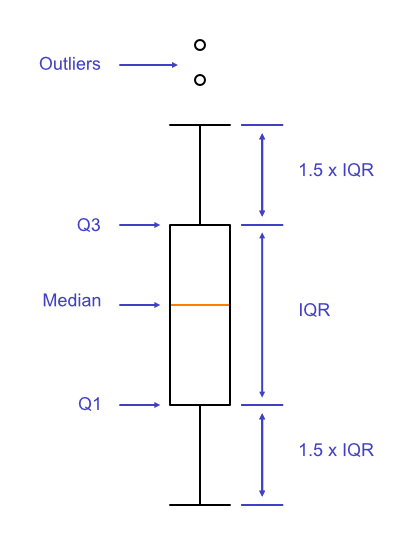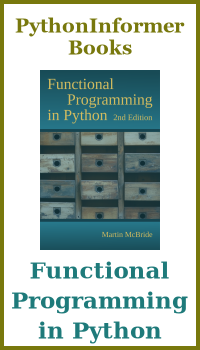Box plots in Matplotlib
Categories: matplotlib

We have previously used bar charts to show the average temperature of each month.
Box plots show the average temperature of each month, but they also indicate the spread of temperatures for each month.
Example box plot
Here is a box plot of monthly temperatures for 2009:

The bar and whisker figure for each month is based on the data for all the days in that month, so there are between 28 and 31 temperatures represented by each figure, depending on the month.
Here is one box in a bit more detail:

The box is based on the quartiles of the data. To find the quartiles, we arrange the values of the data set in increasing order, then we divide the list into 4 equal parts:

- The first quartile (Q1) is the upper boundary of the first group. A quarter of the values of the set are less than Q1.
- The median is the upper boundary of the second group. Half of the values of the set are less than the median. The median is also known as the second quartile (Q2).
- The third quartile (Q3) is the upper boundary of the third group. Three-quarters of the values of the set are less than Q3.
The box stretches from Q1 to Q3, with the median indicated by the orange line.
The interquartile range (IQR) is the distance between Q1 and Q3 (ie it is Q3 - Q1).
The lower whisker usually indicates the smallest data point. However, the length of the whisker is limited to 1.5 times the IQR. So it will indicate the smallest value that is not less than:
Q1 - 1.5 * IQR
Any points that are less than this value are called outliers and are indicated separately by small circles.
The upper whisker usually indicates the largest data point, and again the length of the whisker is limited to 1.5 times the IQR. So it will indicate the largest value that is not greater than:
Q3 + 1.5 * IQR
Any points that are greater than this value are also outliers, and again are indicated separately by small circles.
Creating a simple box plot
Here is the code to create the plot above:
import matplotlib.pyplot as plt
import csv
with open("2009-temp-monthly-list.csv") as csv_file:
csv_reader = csv.reader(csv_file, quoting=csv.QUOTE_NONNUMERIC)
temperature = list(csv_reader)
month_names = ["J", "F", "M", "A", "M", "J",
"J", "A", "S", "O", "N", "D"]
months = range(12)
plt.title("Temperature box plot 2009")
plt.xlabel("Month")
plt.ylabel("Temperature")
plt.boxplot(temperature, positions=months)
plt.xticks(months, month_names)
plt.show()
The code is here on github, in the file boxplot_temperatures.py.
This is quite similar to creating a bar chart.
The main difference is that we are reading in a list of lists, so we don't need to flatten the list. So we create the temperature list like this:
temperature = list(csv_reader)
This converts the csv_reader object (which is an iterator) into a list, without flattening. Here is the resulting list of lists:
[
[1.2, 3.8, 2.4, 1.7, ...] # 31 values for Jan
[2.7, 0.6, 2.6, ...] # 28 values for Feb
[10.1, 10.3, 9.3, ... ] # 31 values for Mar
...
]
The outer list contains 12 sublists, one for each month. Each sublist contains the temperatures for each day of that particular month, as described earlier.
We make the box plot using plt.boxplot. This accepts the list of lists, and also a positions parameter that we use to place the boxes at x positions 0, 1 ... 11.
Related articles
Join the GraphicMaths/PythonInformer Newsletter
Sign up using this form to receive an email when new content is added to the graphpicmaths or pythoninformer websites:

Popular tags
2d arrays abstract data type and angle animation arc array arrays bar chart bar style behavioural pattern bezier curve built-in function callable object chain circle classes close closure cmyk colour combinations comparison operator context context manager conversion count creational pattern data science data types decorator design pattern device space dictionary drawing duck typing efficiency ellipse else encryption enumerate fill filter for loop formula function function composition function plot functools game development generativepy tutorial generator geometry gif global variable greyscale higher order function hsl html image image processing imagesurface immutable object in operator index inner function input installing integer iter iterable iterator itertools join l system lambda function latex len lerp line line plot line style linear gradient linspace list list comprehension logical operator lru_cache magic method mandelbrot mandelbrot set map marker style matplotlib monad mutability named parameter numeric python numpy object open operator optimisation optional parameter or pandas path pattern permutations pie chart pil pillow polygon pong positional parameter print product programming paradigms programming techniques pure function python standard library range recipes rectangle recursion regular polygon repeat rgb rotation roundrect scaling scatter plot scipy sector segment sequence setup shape singleton slicing sound spirograph sprite square str stream string stroke structural pattern symmetric encryption template tex text tinkerbell fractal transform translation transparency triangle truthy value tuple turtle unpacking user space vectorisation webserver website while loop zip zip_longest
